 |
Special Devotions
The Santos of Provence
Marian T. Horvat
The first time I saw one of the elaborate Christmas crèches of Provence, I was enthralled. Hundreds – or so it seemed – little figurines from all walks of life and professions dressed in traditional Provençal clothing – lined a long winding road heading toward the manger scene with the Infant-God, Our Lady and St. Joseph.
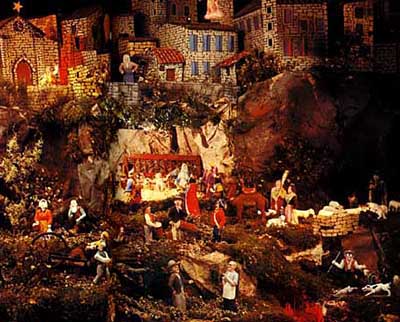
Part of a typical Provençal crèche scenes with all the villagers going and coming to adore the Divine Infant in the Manger | |
In Provence, it is impossible to imagine a Christmas without the elaborate crèches peopled with santos, or saints. Properly speaking, these small statues do not represent saints. They represent the little people of the village who are coming with enthusiasm and piety to welcome the Savior on that holiest of nights.
The first terra-cottas of these santos appeared in Provence in the 18th century, when Italian merchants brought their small brightly painted figurines of Italian villagers to the Fair in Marseille. Local artisans were quick to adopt the custom, making their own santos carved with the expressive features of the village people, wearing the Provençal dress of the period. They also baptized the little figures with French names. And of course, instead of the hills of Bethlehem, the setting became the French countryside, where the crèche belongs.
This popular tradition grew stronger in Provence during the period of the French Revolution. In 1793, the government decreed the closing of the Catholic churches and forbade the public display of holy statues and the crèche scenes. This provoked a general reaction among the people. If they could not have the crèche in the churches, each family would have their own small crèche scene with their santos representing the village people who would join the Magi in the journey to the Manger. No government ordinance would stop the Provençal people from celebrating the birth of Christ.
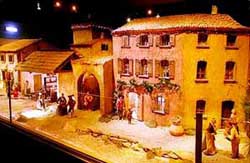
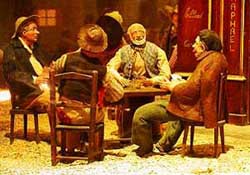
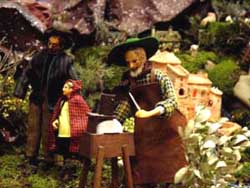
From the top, street scenes of Paradou, a chat in a public place and a knife sharpener are all included in the representation of the Manger
| |
In this way the crèche became the expression of the local life. Under the shining Bethlehem Star and on either side of the Infant God, one finds Mary and Joseph, the donkey and the ox, the sheep and the shepherds. But then come the night watchman, the miller, the poacher, the hunter, the baker, the town notable with his tiny pocket watch hanging from his vest pocket. We also find the fisherwoman with her basketful of catches from the sea, the goose girl with her flocks, the heavy garlic woman with her warts and wrinkles, the beautiful young women of Arles, Aix-en-Provence, Sault, and all the other Provence villages.
Some of the santos are occupied with their daily business, a simple peasant plowing the ground, children playing a circle game, women bartering at the market. Other santos are placed on their way to see Little Jesus in the manger. A drummer boy and youth with a fife lead them. Each one has some small gift to offer the Christ Child: a chicken, a basket of fruit, flowers, a bunch of rope-tied faggots to make a fire and keep the King of Kings warm. The one exception is the town simpleton, who is depicted with his hands in the air astonished that the Son of God has come to earth. A few of the less fortunate, a blind man, a cripple, a pauper, come only with a prayer and expression of great joy.
Then there are the animals, an important part of the world of the peasants and villagers. Here a dog chases a hare, there is the rooster who wakes up the village. A little donkey carries a pack of flour at the side of the husky miller in his white cap. Everywhere are whole flocks of miniature sheep, ducks, geese, pheasants and chickens. Sometimes an exotic animal – a camel, elephant or leopard – makes its way into the entourage of the Three Kings. One animal is never seen and that is the cat. Legend has it that the cat was associated with witchcraft, and was banned from the crèche by St. Francis of Assisi. Legend also has it that to inaugurate a new kiln, the santos maker fires a clay cat until it breaks, thus bringing good luck.
Each year on December 4 the santos leave their sleeping places in the boxes where they were carefully packed away, and with new joy and enthusiasm are set up in a corner of the family house until Candlemas Day, February 2. Children gather the moss and holly to decorate the base; the windmill, village huts and Provençal-style houses and olive trees dot the landscapes, and the little santos occupy their places of honor. The crèches evolve with the times and family tradition. New figures may be purchased at the special santos markets in Marseille, Aix-en-Provence, Avignon or Aubagne. Families rival each other in ingenuity to improve their crèche. The crèche with its santos became a tradition as loved and established as the Thirteen Desserts of Christmas in Provence.
Provence – famous for its santos
Many magnificent old crèches with their distinctive santos are set up every year in churches and town halls in Provence. Each year a schedule is drawn up for those who want to visit the marvelous public crèche displays, each one a small world of fantasy and the marvelous.
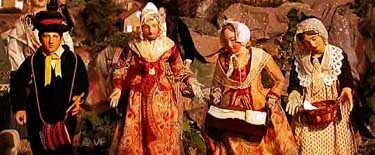
In the Manger scene each profession wears its own clothing: An organic expression of the customs and art of the region | |
The Church at Beausset proudly boasts its crèche has santos that are more than 100 years old. Each year the different families of the village bring several of their treasured pieces for the crèche scene, which are united only at Christmas time. In Grambois, all the santos are effigies of villagers.
The background for the crèche scene at Saint-Antoine Ginestière in Nice is a miniature medieval castle set on a mountain top. Many of its scenes are animated by a series of weights and pulleys that move its figures.
In the magnificent crèche in La Cremade in Vaucluse there are “giant” santos, a foot high. No personality is excluded: even Satan rises from crimson brimstones to tempt the faithful. Grignan en Provence proclaims “the largest crèche in the world” with more than 1,000 santos and 60 Provençal houses, several stately churches and multiple windmills.
Each crèche is, in fact, an idealised representation of a Provençal village, where there is a place for each and every one at the manger of Our Lord.


Related Topics of Interest
 The Night of Christmas The Night of Christmas
 The Shepherd's Prayer The Shepherd's Prayer
 Don't Watch this Protestant Nativity Story Don't Watch this Protestant Nativity Story
 The Venerability of St. Joseph The Venerability of St. Joseph
 The Twelve Days of Christmas The Twelve Days of Christmas
 The Fullness of Time The Fullness of Time

|
Special Devotions | Religious | Home | Books | CDss | Search | Contact Us | Donate

© 2002- Tradition in Action, Inc. All Rights Reserved
|
 |
|